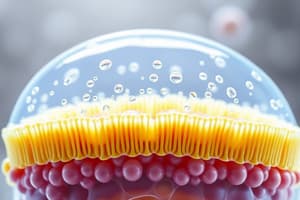Podcast
Questions and Answers
Lateral diffusion is a process where lipids and proteins move from one leaflet of the lipid bilayer to the other.
Lateral diffusion is a process where lipids and proteins move from one leaflet of the lipid bilayer to the other.
False (B)
Which of the following factors increases membrane fluidity?
Which of the following factors increases membrane fluidity?
The movement of water across a semi-permeable membrane from an area of ______ water concentration to an area of ______ water concentration is called osmosis.
The movement of water across a semi-permeable membrane from an area of ______ water concentration to an area of ______ water concentration is called osmosis.
Which of the following is NOT a component of the plasma membrane?
Which of the following is NOT a component of the plasma membrane?
Signup and view all the answers
The plasma membrane is a rigid and inflexible barrier that prevents all substances from entering or exiting the cell.
The plasma membrane is a rigid and inflexible barrier that prevents all substances from entering or exiting the cell.
Signup and view all the answers
What is the primary function of the plasma membrane?
What is the primary function of the plasma membrane?
Signup and view all the answers
The plasma membrane is primarily composed of a ______ bilayer.
The plasma membrane is primarily composed of a ______ bilayer.
Signup and view all the answers
Match the lipid type with its primary function in the plasma membrane.
Match the lipid type with its primary function in the plasma membrane.
Signup and view all the answers
Which of the following is a function of proteins embedded in the plasma membrane?
Which of the following is a function of proteins embedded in the plasma membrane?
Signup and view all the answers
Peripheral proteins are embedded within the lipid bilayer and span the membrane.
Peripheral proteins are embedded within the lipid bilayer and span the membrane.
Signup and view all the answers
What is the glycocalyx, and what is its role in the cell?
What is the glycocalyx, and what is its role in the cell?
Signup and view all the answers
Which statement best describes the function of cholesterol in the plasma membrane?
Which statement best describes the function of cholesterol in the plasma membrane?
Signup and view all the answers
Passive transport requires energy to move substances against their concentration gradient.
Passive transport requires energy to move substances against their concentration gradient.
Signup and view all the answers
What are the three types of endocytosis?
What are the three types of endocytosis?
Signup and view all the answers
The _______ is a channel that allows small molecules and ions to pass directly between cells for communication.
The _______ is a channel that allows small molecules and ions to pass directly between cells for communication.
Signup and view all the answers
Match the following types of transport with their descriptions:
Match the following types of transport with their descriptions:
Signup and view all the answers
Which type of cell junction is designed to prevent leakage of substances between cells?
Which type of cell junction is designed to prevent leakage of substances between cells?
Signup and view all the answers
What is the primary role of the sodium-potassium pump?
What is the primary role of the sodium-potassium pump?
Signup and view all the answers
Flashcards
Plasma Membrane
Plasma Membrane
A selectively permeable barrier surrounding cells, controlling substance movement.
Lateral diffusion
Lateral diffusion
Movement of lipids and proteins side-to-side within their leaflet in the membrane.
Phospholipids
Phospholipids
Major lipids that form the bilayer, having a hydrophilic head and hydrophobic tails.
Flip-flop
Flip-flop
Signup and view all the flashcards
Cholesterol
Cholesterol
Signup and view all the flashcards
Saturated fatty acids
Saturated fatty acids
Signup and view all the flashcards
Glycolipids
Glycolipids
Signup and view all the flashcards
Integral Proteins
Integral Proteins
Signup and view all the flashcards
Unsaturated fatty acids
Unsaturated fatty acids
Signup and view all the flashcards
Peripheral Proteins
Peripheral Proteins
Signup and view all the flashcards
Passive transport
Passive transport
Signup and view all the flashcards
Sodium-potassium pump
Sodium-potassium pump
Signup and view all the flashcards
Glycocalyx
Glycocalyx
Signup and view all the flashcards
Cell junctions
Cell junctions
Signup and view all the flashcards
Amphipathic Lipids
Amphipathic Lipids
Signup and view all the flashcards
Study Notes
Plasma Membrane Structure and Function
- The plasma membrane is a selectively permeable barrier around a cell, controlling what enters and exits.
- It's composed primarily of lipids, proteins, and carbohydrates with specific roles.
Membrane Lipids
- Phospholipids: Amphipathic molecules (hydrophilic head, hydrophobic tails) forming a bilayer.
- Cholesterol: Embedded in the bilayer, affecting fluidity and stability.
- Glycolipids: Lipids with carbohydrate chains, involved in cell recognition.
Membrane Proteins
- Integral proteins: Embedded in the bilayer, spanning the membrane. Act as channels, carriers, or receptors.
- Peripheral proteins: Loosely attached to the membrane, involved in signaling and structure.
Membrane Carbohydrates
- Attached to lipids (glycolipids) or proteins (glycoproteins).
- Form the glycocalyx, a carbohydrate-rich layer on the cell surface. Crucial for cell recognition, adhesion, and protection.
Lipid Aggregates in Water
- Micelles: Spherical structures with hydrophobic tails inward, hydrophilic heads outward.
- Bilayers: Two layers of phospholipids with tails inward, heads outward, forming the membrane structure.
- Liposomes: Closed bilayer structures that carry substances inside.
Lipid Movement in the Bilayer
- Lateral diffusion: Rapid side-to-side movement within a phospholipid layer.
- Flip-flop: Rare movement of lipids from one layer to the other (requires energy).
Factors Influencing Membrane Fluidity and Composition
- Fatty acid saturation: Saturated fatty acids decrease fluidity, while unsaturated acids increase it.
- Cholesterol content: Stabilizes at low temperatures, limits excessive fluidity at high temperatures.
- Temperature: Higher temperatures increase fluidity, lower temperatures decrease it.
Membrane Functions
- Selective permeability: Controls what enters and exits the cell.
- Compartmentalization: Separates intracellular and extracellular environments.
- Communication: Contains receptors facilitating cell-cell and cell-environment communication.
- Transport: Facilitates ion and molecule movement.
Membrane Transport
- Passive Transport (no energy):
- Simple diffusion: Small non-polar molecules (e.g., oxygen, CO2) pass directly through the bilayer.
- Facilitated diffusion: Larger/charged molecules (e.g., ions, glucose) pass through protein channels or carriers.
- Osmosis: Water diffusion across a selectively permeable membrane.
- Active Transport (energy required):
- Sodium-Potassium pump (Na+/K+ pump): Maintains electrochemical gradient using ATP, crucial for nerve transmission.
Endocytosis and Exocytosis
- Endocytosis: Uptake of materials from the environment, forming vesicles within the cell.
- Phagocytosis: Engulfing large particles.
- Pinocytosis: Engulfing liquids/small molecules.
- Receptor-mediated endocytosis: Specific molecules bind to receptors initiating vesicle formation.
- Exocytosis: Exporting materials from the cell by fusing vesicles with the membrane.
Cell Junctions
- Connect cells, allowing communication, transport, and maintaining tissue integrity.
- Tight junctions: Prevent leakage between cells.
- Desmosomes: Provide mechanical strength.
- Gap junctions: Channels for small molecules to pass between cells, aiding in communication.
Studying That Suits You
Use AI to generate personalized quizzes and flashcards to suit your learning preferences.
Description
Explore the essential components and functions of the plasma membrane in this quiz. Covering lipids, proteins, and carbohydrates, you will learn how these elements contribute to the cell's selective permeability and overall function. Perfect for students studying cell biology.




